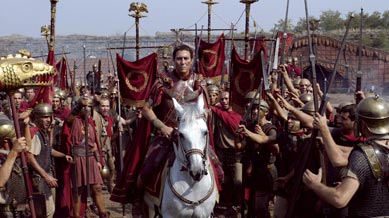
ROME (2005, Farino)
.
Here’s a TV show, but no wonder Rome is cinematic to its roots, as its pilot and first few episodes were directed by feature helmer (and charming fellow) Michael Apted, who is also the director of the amazing, on-going “(insert age here) Up” documentary series, incidentally.
This shot, directed by Julian Farino, the first director to take the helm from Apted on the series, is from the first-season episode Stealing from Saturn and is deceptively simple-looking. A lot is happening in this shot, on numerous levels (first off, it’s a whole scene!), the political machinations, the character revelations, the subtextual cat-and-mouse, the sense of over-hearing a secret moment, the photographic depth, the impressionistic use of extras – all in one shot, with each character’s turn to the lens perfect for its dramatic beat. (And how about Roger Hammond‘s impeccably nuanced performance as the rotund Chief Augur who is being bribed?!) I would guess that this scene played so strongly on the page that, in the director’s mind, there was no doubt it would play as is. (Though I wonder if he was running out of time at the end of his day, as in these posts on Willy Wonka and Hard Pill.)
Little set-up: that’s Cerian Hinds as Caeser, realizing he must bribe Chief Augur in order that the religious leaders approve Caeser’s becoming leader of Rome.
Directing Commercial versus Premium/Streaming Television
Something that feature film and pay-TV directors don’t have to worry about as much as their commercial TV counter-parts is the exactitude of an episode’s running time. In features and premium fare, it’s not that much of a problem if a program or film runs over a couple minutes, as long as it serves story. But on commercial TV, those extra moments are ad space, god forbid, and therefore every second is accounted for – even at the expense of story.
While limitations can often push an artist to greater heights, I think most of the time in this context we pay in quality of story telling – whether it be in the loss of story-enriching character or plot beats, or in the dumbing down of the actual direction. Committing to an imaginative and effective single shot and staging such as this can be especially risky (maybe even impossible) if you know you’re eventually going to be forced to cut minutes off your running time. Suddenly every scene is shot in water-downed coverage that removes all sense of artistry but allows for maximum timing variations. The intentions shift from service of the story to enslavement to the time allotment.
So that’s one of the reasons why when watching television I get especially excited with a bold and engaging blocking such as this. Another reason, and the main one: though it looks really easy, no matter which medium you’re working in — features, paid or commercial TV — this kind of eloquent work is incredibly difficult. Kudos to Farino for making it look so effortless.
P.S. Hammond’s breathless revelation when he says “Her birthday,” realizing he’s about to get a big pay off, is just the bee’s knees.